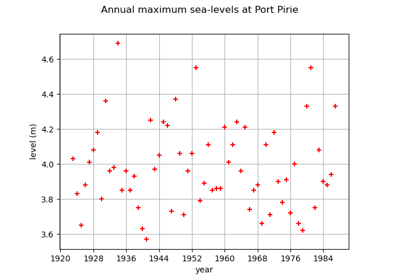TimeVaryingResult¶
- class TimeVaryingResult(*args)¶
Estimation result class for a non stationary GEV or GPD model.
- Parameters:
- factory
DistributionFactory Parent distribution factory.
- data2-d sequence of float
Sample drawn from
.
- parameterFunction
Function The function
.
- timeStamps2-d sequence of float
Values of
.
- parameterDistribution
Distribution The distribution of
.
- normalizationFunction
LinearFunction The normalization function
.
- llhfloat
Maximum log-likelihood.
- factory
Methods
Draw the 4 usual diagnostic plots.
drawParameterFunction([parameterIndex])Draw the parameter function.
Draw the quantile function.
Accessor to the object's name.
Accessor to the Parent distribution at a given time.
Optimal log-likelihood value accessor.
getName()Accessor to the object's name.
Normalizing function accessor.
Optimal parameter accessor.
Accessor to the distribution of
.
Parameter function accessor.
Accessor to the time grid.
hasName()Test if the object is named.
setLogLikelihood(logLikelihood)Optimal log-likelihood value accessor.
setName(name)Accessor to the object's name.
setParameterDistribution(parameterDistribution)Accessor to the distribution of of
.
See also
Notes
This class is created by the method
buildTimeVarying()of the classesGeneralizedExtremeValueFactoryandGeneralizedParetoFactory.Let
be a non stationary random variable which follows a GEV distribution or whose excesses above
follow a GPD. The parameters of the GEV or GPD model depend on
:
For the GPD, the threshold
is assumed to be known.
We denote by
the values of
on the time stamps
.
For numerical reasons, the time stamps have been normalized using the linear function:
Let
be the set of parameters
for the GEV model and
for the GPD. Each component
can be written as a function of
:
where:
is the size of the functional basis involved in the modelling of
,
is usually referred to as the inverse-link function of the component
,
each
is a scalar function
,
each
.
We denote by
the complete vector of parameters.
The estimator of the vector
maximizes the likelihood of the Parent distribution (ie the distribution of
).
- __init__(*args)¶
- drawDiagnosticPlot()¶
Draw the 4 usual diagnostic plots.
- Returns:
- grid
GridLayout - Returns a grid of 4 graphs:
the QQ-plot,
the PP-plot,
the return level graph (with confidence lines),
the density graph.
- grid
Notes
Let
be a non stationary random variable which follows a GEV distribution or whose excesses above
follow a GPD. The parameters of the GEV or GPD model depend on
:
Then, the standardized variables
defined respectively by:
respectively follows the standard Gumbel distribution (which is the GEV model with
) or the standard Exponential distribution (which is the GPD with
).
Then, the 4 usual diagnostic graphs are built from the transformed data compared to the Gumbel or Exponential model:
the probability-probability plot,
the quantile-quantile plot,
the return level plot,
the data histogram with the Gumbel/Exponential distribution.
If
denotes the ordered transformed data, the graphs are defined as follows.
The probability-probability plot consists of the points (respectively for the GEV and GPD models):
The quantile-quantile plot consists of the points (respectively for the GEV and GPD models):
The return level plot consists of the points:
and the points:
where
is the empirical
-block return level (for the GEV model) or the
-observation return level (for the GPD model) of the transformed data and
the same quantity evaluated from the Gumbel/Exponential distribution.
- drawParameterFunction(parameterIndex=0)¶
Draw the parameter function.
- Parameters:
- parameterIndexint,
The index
specifying the component of
.
- Returns:
- graph
Graph Graph of
.
- graph
- drawQuantileFunction(p)¶
Draw the quantile function.
- Parameters:
- pfloat
The quantile level.
- Returns:
- graph
Graph Quantile function graph.
- graph
Notes
The quantile function is the function
where
is the quantile of order
of the Parent distribution at time
.
- getClassName()¶
Accessor to the object’s name.
- Returns:
- class_namestr
The object class name (object.__class__.__name__).
- getDistribution(t)¶
Accessor to the Parent distribution at a given time.
- Parameters:
- tfloat
Time value.
- Returns:
- distribution
Distribution The Parent distribution at time t.
- distribution
- getLogLikelihood()¶
Optimal log-likelihood value accessor.
- Returns:
- llhfloat
Maximum log-likelihood.
- getName()¶
Accessor to the object’s name.
- Returns:
- namestr
The name of the object.
- getNormalizationFunction()¶
Normalizing function accessor.
- Returns:
- normalizeFunction
Function The function
.
- normalizeFunction
- getOptimalParameter()¶
Optimal parameter accessor.
- Returns:
- optimalParameter
Point Optimal vector of parameters
.
- optimalParameter
- getParameterDistribution()¶
Accessor to the distribution of
.
- Returns:
- parameterDistribution
Distribution The distribution of the estimator of
.
- parameterDistribution
- getParameterFunction()¶
Parameter function accessor.
- Returns:
- parameterFunction
Function The function
.
- parameterFunction
- hasName()¶
Test if the object is named.
- Returns:
- hasNamebool
True if the name is not empty.
- setLogLikelihood(logLikelihood)¶
Optimal log-likelihood value accessor.
- Parameters:
- llhfloat
Maximum log-likelihood.
- setName(name)¶
Accessor to the object’s name.
- Parameters:
- namestr
The name of the object.
- setParameterDistribution(parameterDistribution)¶
Accessor to the distribution of of
.
- Parameters:
- parameterDistribution
Distribution The distribution of the estimator of
.
- parameterDistribution
 OpenTURNS
OpenTURNS



